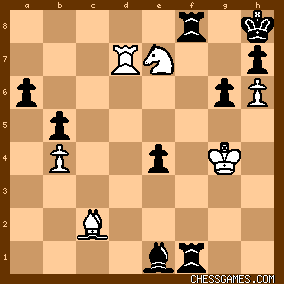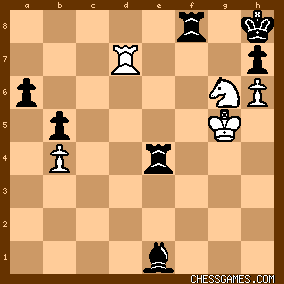|
< Earlier Kibitzing · PAGE 2 OF 4 ·
Later Kibitzing> |
Apr-20-13
 | | OhioChessFan: Got it quickly, but mostly because I had mentioned Crazy Rooks on the Chessgames.com forum yesterday and it was still in mind. <mike1> 46..Qb5 47. Bc4 Qa4 etc etc etc If 46. Bb3 Qb5 47. Bc4 Qxc4 48. Re8+ Kc7 49. Rc8+ Kd6 50. Rd8+ Ke5 51. Qe4+ Kf7 52. Rf8+ Qf7 53. Rxf7+ Kxf7 and an interesting position

click for larger view |
|
| Apr-20-13 | | JohnBoy: This is amazing. I looked hard at 46.Bb3, trying to distract the black queen long enough to secure a perpetual. I even understood that white was almost out of moves. But 47.Qf4+ never entered my mind. |
|
| Apr-20-13 | | thegoodanarchist: A surprising conclusion! Wow. |
|
| Apr-20-13 | | schweigzwang: That's fantastic. |
|
| Apr-20-13 | | goldenbear: I got it. I'm feeling pretty good about myself right now. Incidentally, I think I would have found this in a real game too, since the only option other than Bb3 and Qf4+ is resignation. This was easier than it seems because nothing else was plausible. |
|
| Apr-20-13 | | sethoflagos: White's cannot deliver a forced sequence due to massive material loss and black's total control of c6 (eg. 46.Rb7+ Kxb7 47.Qe4+ Qc6  ) )Black threatens both 46...Qd1# & 46...Qc2+ 47.Ka1 Qc1/d1 requiring white to block both c2 and d1 in a single move. Only three possible candidates: 47.Kc1 Qc2#
47.b3 Qa2+ 48.Kc1 Qc2#
Therefore, white has but one option: 47.Bb3. |
|
| Apr-20-13 | | Ray C: An "eternal rook" position, rather like Larry Evans vs Reshevsky, 1963. Nice. |
|
| Apr-20-13 | | kevin86: stalemate trap! Ouch! |
|
| Apr-20-13 | | BOSTER: For me move Bb3 was appearred like comet and immediately disappeared leaving me without the solution.
But this is really a great puzzle. Thanks <CG>. |
|
Apr-20-13
 | | FSR: I'm pretty sure that this is the greatest stalemating combination of all time in actual play, as opposed to a composition. Note that White had <six> pieces, all of which had legal moves, prior to 46.Bb3!! (See my Game Collection: Stalemate! for some more examples.) Does anyone disagree? |
|
| Apr-20-13 | | waustad: I even looked at the bishop sac as part of a way to get a perp, but didn't see how to get a stalemate trap with the f pawn there. Nice swindle. |
|
| Apr-20-13 | | cormier: if 43...Qxa4:

click for larger viewAnalysis:
1.  (-13.51): 44.Rc3 Ndc2 45.Kc1 Rd7 46.Qxd7 Qxd7 47.Rxc2 Nxc2 48.Kxc2 h3 49.Be6 Qh7 50.Bxh3 Qxh3 51.Re3 Kc7 52.Kd2 Qg2+ 53.Kc1 Qf1+ 54.Kd2 Qf2+ 55.Re2 Qxf3 56.Re3 Qf4 57.Ke2 Qh2+ 58.Kf1 Qxb2 59.Re7+ Kc6 60.Re6+ Kb5 61.Re2 Qf6+ 62.Kg2 a4 63.Kh2 Qd4 64.Rg2 a3 65.Re2 Qb2 __________________________________________
2. (-13.51): 44.Rc3 Ndc2 45.Kc1 Rd7 46.Qxd7 Qxd7 47.Rxc2 Nxc2 48.Kxc2 h3 49.Be6 Qh7 50.Bxh3 Qxh3 51.Re3 Kc7 52.Kd2 Qg2+ 53.Kc1 Qf1+ 54.Kd2 Qf2+ 55.Re2 Qxf3 56.Re3 Qf4 57.Ke2 Qh2+ 58.Kf1 Qxb2 59.Re7+ Kc6 60.Re6+ Kb5 61.Re2 Qf6+ 62.Kg2 a4 63.Kh2 Qd4 64.Rg2 a3 65.Re2 Qb2 __________________________________________
2.  (-16.59): 44.Qg1 Qc2+ 45.Ka1 Rxe4 46.fxe4 Qxc4 47.b3 Nxb3+ 48.Rxb3 Qxb3 49.Qh2+ Kb7 50.Qb2 Qxb2+ 51.Kxb2 h3 52.Kc1 h2 53.Kd2 h1Q 54.Ke3 Qf1 55.e5 a4 56.e6 Nc2+ 57.Ke4 Nd4 58.Kd5 Qf5+ 59.Kc4 Qxe6+ 60.Kc3 Qb3+ 61.Kd2 Qc2+ 62.Ke3 _________________________________________
3. (-16.59): 44.Qg1 Qc2+ 45.Ka1 Rxe4 46.fxe4 Qxc4 47.b3 Nxb3+ 48.Rxb3 Qxb3 49.Qh2+ Kb7 50.Qb2 Qxb2+ 51.Kxb2 h3 52.Kc1 h2 53.Kd2 h1Q 54.Ke3 Qf1 55.e5 a4 56.e6 Nc2+ 57.Ke4 Nd4 58.Kd5 Qf5+ 59.Kc4 Qxe6+ 60.Kc3 Qb3+ 61.Kd2 Qc2+ 62.Ke3 _________________________________________
3.  (-16.18): 44.Bb3 Nxb3 45.Rxb4 Qa1+ 46.Kc2 Qc1+ 47.Kxb3 Rxe3+ 48.Ka4 cxb4 49.Qd7 Qc5 50.f4 gxf4 51.b3 Qe7 52.Qc6 Qe8 53.Kb5 Qxc6+ 54.Kxc6 Rxb3 55.Kxb6 h3 56.Kxa5 h2 57.Ka4 Kc7 (-16.18): 44.Bb3 Nxb3 45.Rxb4 Qa1+ 46.Kc2 Qc1+ 47.Kxb3 Rxe3+ 48.Ka4 cxb4 49.Qd7 Qc5 50.f4 gxf4 51.b3 Qe7 52.Qc6 Qe8 53.Kb5 Qxc6+ 54.Kxc6 Rxb3 55.Kxb6 h3 56.Kxa5 h2 57.Ka4 Kc7 |
|
Apr-20-13
 | | Sneaky: Definitely one for my Game Collection: Crazy Rooks. |
|
| Apr-20-13 | | bengalcat47: Anyone up for shredded gull? |
|
| Apr-20-13 | | James D Flynn: 46.Bb3ingenious and beautiful. If the reply is Qxb3 R e8+ leads to mate/ |
|
| Apr-20-13 | | kaingero: Just wondering if this draw combination would ever be perceived by human minds when this happened in actual game played by humans.
Will there come a time when computer programs be allowed to play in chess tournament, then become a world chess championship contender.
Then maybe human chess players would be a thing of the past... |
|
| Apr-20-13 | | Abdel Irada: <FSR: I'm pretty sure that this is the greatest stalemating combination of all time in actual play, as opposed to a composition. Note that White had <six> pieces, all of which had legal moves, prior to 46.Bb3!! (See my Game Collection: Stalemate! for some more examples.) Does anyone disagree?> For obvious reasons, it will never enter the <chessgames.com> database, and I can't say it was "greater" than this game, but the latter does remind me of an offhand game I played in 1984. At the time, I was about 1850, and no match for the elderly Filipino master I was playing. I mishandled his Sicilian, and soon found myself in this position (or something very like it): 
click for larger view[Desperation: White to play]
In this position, White is of course dead lost; in a tournament, the scoresheets would probably have been signed and submitted. But this game was offhand, and I had one slight hope: my opponent's rapidly fraying patience. I therefore made a desperate gamble: <1. Bxe4?!> Black continued logically: <1. ...R1f4† 2. Kg5>. Now, had Black looked calmly at the position, he would have seen 2. ...Bh4#. But Black's last move before the diagram position, ...Raf8, was intended to set a trap, so without looking he executed the trap and sat back to await my resignation. And so Black continued <2. ...Rxe4?>, allowing what I'd been banking on: <3. Nxg6†>. Now Black must take the knight or be mated. 
click for larger view[Swindled!: The position after 3. Nxg6†]
The game finishes <3. ...hxg6 4. Rh7†> and ends in a draw, either by perpetual check, if Black doesn't take the rook, or in stalemate for White if he does. To this day, from the lack of expression on my opponent's face as he shook my hand and we departed the playing hall, I am still not sure if he understood that he'd stalemated me, or if he took my moves as a form of resignation. |
|
| Apr-20-13 | | Patriot: White is up the exchange for 3 pawns. Black threatens mate in one (46...Qd1#) or 46...Qc2+ and mate on d1 or c1. Given black is winning materially and threatens mate, white must at least aim for perpetual. The only thing I see here is 46.Rb7+ Kxb7 47.Qe4+ Ndc6 48.Qh7+. I'm not even sure this works but I don't see any other options after looking at other candidates (Bb3, Qf4+). --------
I'm not sure what I was thinking. I even calculated this line and thought for some reason that white had to avoid 50.Rd7+ because of 50...Qxd7 but that doesn't eliminate a perpetual. This caused me to think perpetual didn't exist in that line. Plus I even noticed 46.Bb3 Qxb3 47.Re8+, winning for white. Very strange! |
|
| Apr-20-13 | | Patriot: I also remember thinking 46.Bb3 Qc6, but I guess 47.Qxg5 may be playable and possibly winning. |
|
| Apr-21-13 | | Abdel Irada: <Plus I even noticed 46.Bb3 Qxb3 47.Re8+, winning for white.> Actually, White doesn't win unless Black blunders. After 46. ...Qxb3 47. Re8†, Kc7, White has nothing better than to repeat moves with 48. Re7†, since neither 48. Qc8† nor 48. Rc8† wins, and to play either would only make the draw more problematical. (I learned this the hard way, having spent hours in a fruitless search for a win in that line.) |
|
| Apr-21-13 | | Patriot: <I even calculated this line and thought for some reason that white had to avoid 50.Rd7+ because of 50...Qxd7 but that doesn't eliminate a perpetual.> I meant <...but that doesn't eliminate a draw.> |
|
| Apr-21-13 | | Patriot: <Abdel Irada> I should have said "...probably winning for white." which is more in line with what I was thinking. White's attack looked strong so I didn't want to spend a lot of time on what should be an advantageous line for white. Houdini recommends after <46.Bb3 Qxb3>, 47.Re8+ Kc7 48.Rc8+. White has a +1.16 pawn advantage. I didn't think white had any worries. |
|
Apr-21-13
 | | FSR: <Abdel Irada> Nice one! Quite unsound of course, but it must have been fun to play. Alas, I've never been on either side of a memorable stalemating combination. Most of my stalemates have been in the form of accidentally stalemating someone in an Internet blitz game where I had many extra pieces but three seconds on the clock. Incidentally, if you haven't seen it before, take a look at my composition at the bottom of User: FSR. |
|
| Apr-21-13 | | goodevans: <FSR: I'm pretty sure that this is the greatest stalemating combination of all time in actual play, as opposed to a composition.> I'm not going to disagree, but maybe the greatest <by a human> is Kasparov vs N McDonald, 1986, especially when you consider that <Garry was the victim>. Although not forcing, Neil clearly had the stalemate in mind when he marched his K over to h6 and into what looks like a mating net. Perhaps I'm being biased as I was a member of the same chess club as Neil. |
|
Apr-21-13
 | | FSR: <goodevans> That is a nice one, no doubt, particularly considering that in addition to the game line, there is the variation 55.Kh4 Rg4+! 56.Kxg4 Qd7+! I'm fond enough of it to have included it in my Wikipedia article on swindles. http://bit.ly/10s7qj3 But it pales in comparison to (a) Keres vs Fischer, 1962, in terms of number and complexity of variations (see analysis at http://bit.ly/XYAFsg) and (b) S Boyd vs T Glimbrant, 1992, among others, in terms of number of mobile pieces prior to the stalemating combination (R, N, Q, and P in Boyd-Glimbrant). |
|
 |
 |
|
< Earlier Kibitzing · PAGE 2 OF 4 ·
Later Kibitzing> |





